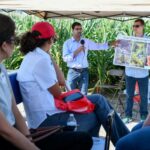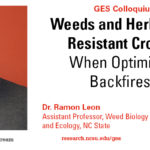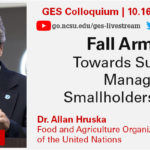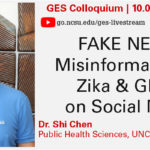
The ‘Public Good’ of Controlling Mobile Pests with Genetically Engineered Crops
Margaret Huffman, Nov. 11 2020 | Choosing to plant genetically engineered seed that will grow insect-resistant corn (Bt corn) is more expensive at the time of planting but is common practice in places like the United States and the Philippines. This study takes a closer look at those who do not plant genetically engineered seed because their neighbors use of Bt corn eliminated the local pest pressure....Continue reading "The ‘Public Good’ of Controlling Mobile Pests with Genetically Engineered Crops"

Federico Ciliberto – Valuing product innovation: genetically engineered varieties in US corn and soybeans | GES Colloquium
Dr. Federico Ciliberto, an economist from of the University of Virginia, will discuss the welfare impacts of genetically engineered (GE) crop varieties of corn and soybeans....
GES Colloquium | Qian Xu – User Engagement in Public Discourse on GMOs
GES Colloquium, 1/15/18 - Qian Xu | This study adopted a quantitative content analysis to examine how source attributes of opinion leaders and their message framing influenced user engagement in the public discourse of genetically modified organisms on Chinese social media. ...Continue reading "GES Colloquium | Qian Xu – User Engagement in Public Discourse on GMOs"

GES Colloquium | Ramon Leon – Weeds and Herbicide Resistant Crops: When Optimism Backfires
GES Colloquium, 1/22/19 - Ramon Leon | The rapid evolution of herbicide resistant weeds and the lack of new herbicides has prompted a reevaluation of how HR crops should be considered just a component within a more complex integrated management system and not as the sole tool for ensuring weed control. The excessive optimism that the agricultural and scientific community exhibited during the first years of use of glyphosate resistant crops reduced our ability to identify the limitations of the technology and the negative consequences of not taking corrective actions on time.This is a cautionary tale that should inform the introduction and use of new HR traits....
Colloquium Follow-up Discussion with Kelly Bronson
Discussion with Kelly Bronson Follow-up discussion after Dr. Bronson’s Colloquium on 9/25. Kelly Bronson will be leading a discussion of Phil Mirowski’s recent article, “The future(s) of open science” (2018). This paper will provide a...Continue reading "Colloquium Follow-up Discussion with Kelly Bronson"

Allan Hruska – Fall Armyworm: Towards Sustainable Management by Smallholders in Africa
10/16 Colloquium: Allan Hruska | Abstract: Fall Armyworm (Spodoptera frugiperda) (FAW) is an important crop pest in the Americas, especially in tropical and sub-tropical areas where it can overwinter. FAW was confirmed in Africa in early 2016 and has quickly spread across Sub-Saharan Africa and beyond. Recently it has been confirmed in India and Yemen. It is now infesting tens of millions of acres of maize across Africa, and rapidly moving on to sorghum and millets....
Shi Chen – ‘Fake News: GMOs and Zika’
10/9 Colloquium: Shi Chen | Abstract: Social media have become an integral part of public health communication. More and more individuals first resort to social media for information during health crisis and disease outbreaks. While the low cost and easy access of social media make it more convenient for health communicators to disseminate useful information to the general public, they also have the side effect of enabling wide and fast spread of fake health news....
NBC News – Gould: Exposure levels determine toxicity of glyphosate
“With all things, it is the level of exposure that matters,” said Fred Gould, head of the Genetic Engineering and Society Center at North Carolina State University. “The poison is in the concentration.”...Continue reading "NBC News – Gould: Exposure levels determine toxicity of glyphosate"
